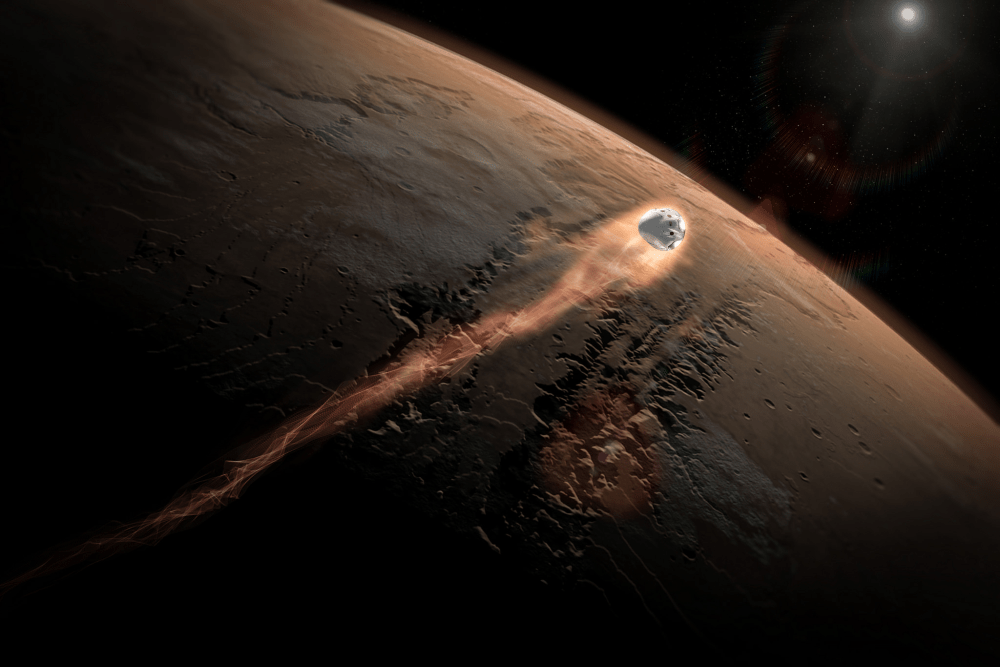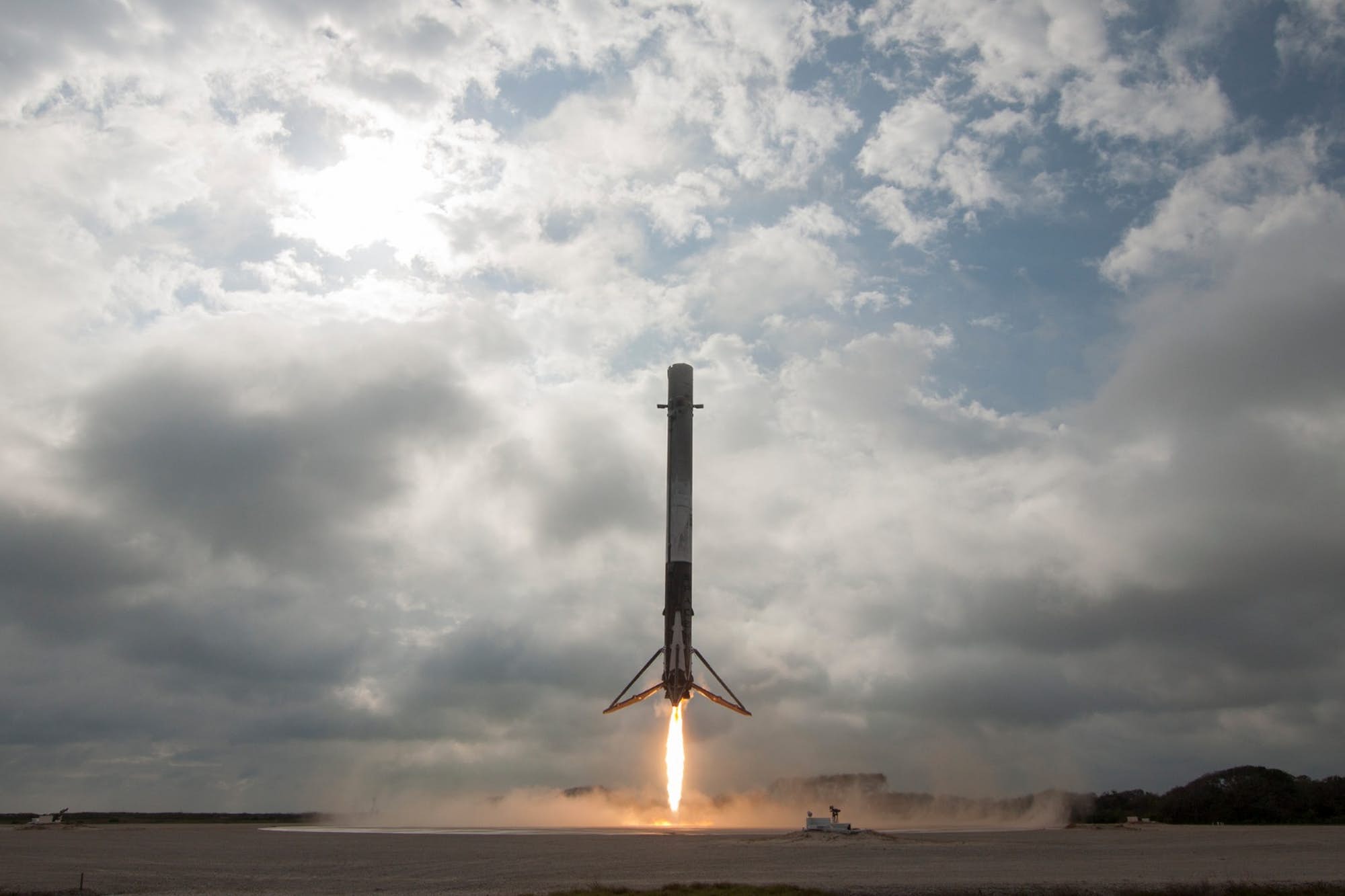You might remember the story of the two astronauts on board the International Space Station that went for an 8 day mission, that was back in June 2024! Butch Wilmore and Suni Williams have been stranded there ever since but their ride home has just arrived at the ISS. A SpaceX Crew Dragon capsule carrying Nick Hague and Aleksandr Gorbunov has just docked so that the two can join the Expedition 72 crew already on board. There are now 11 people on boar the ISS but the Crew-9 capsule will return in February carrying Wilmore and Williams finally back home.
Continue reading “Stranded Astronauts To Get Their Ride Home”Axiom’s First Astronauts Return From International Space Station
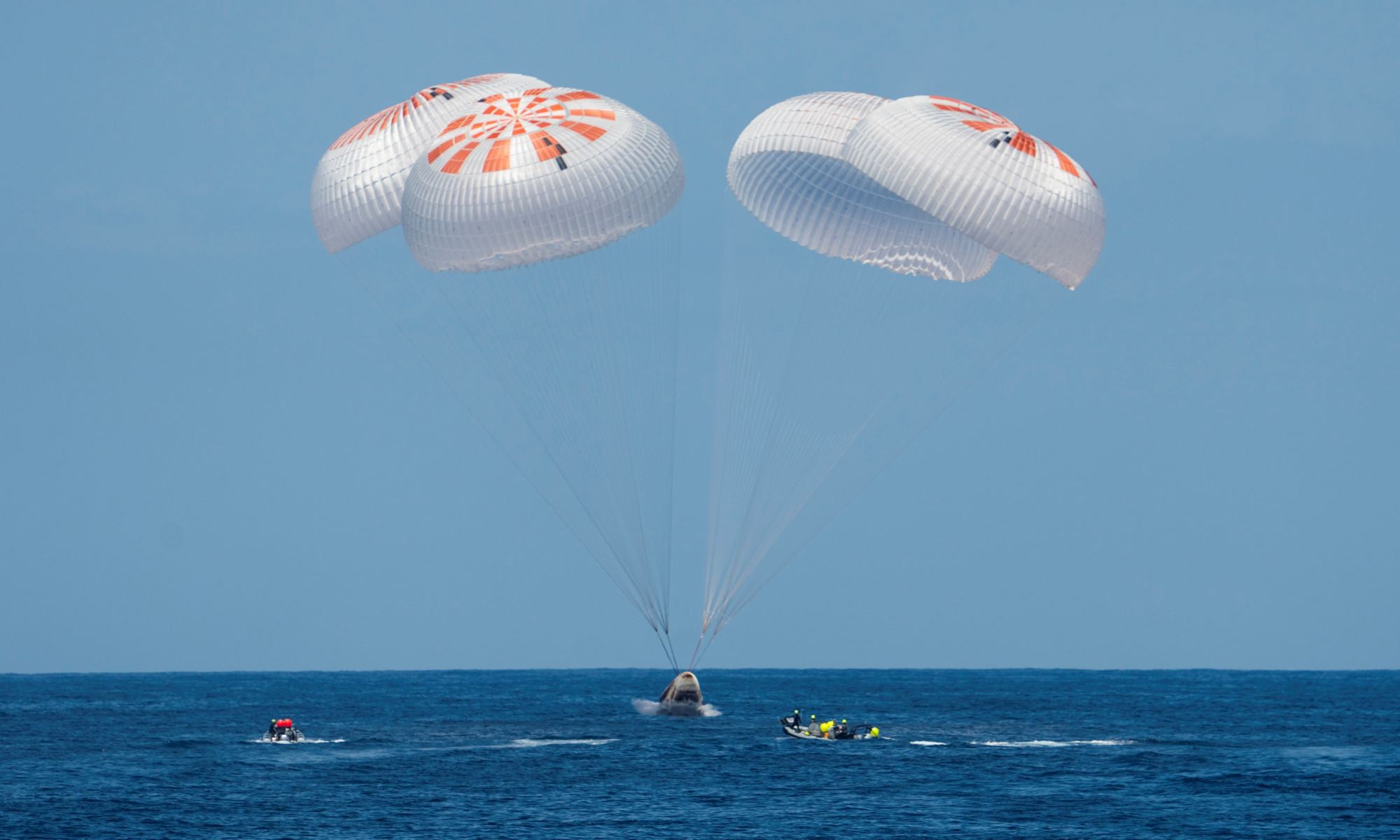
Axiom Space’s first crew of private astronauts is back on Earth after a 17-day orbital trip that included a week of bonus time on the International Space Station. The mission ended at 1:06 p.m. ET (5:06 p.m. GMT) today when SpaceX’s Crew Dragon Endeavour splashed down in the Atlantic Ocean off the coast of Florida.
Former NASA astronaut Michael Lopez-Alegria was the commander for the homeward trip, accompanied by three investors who each paid Axiom $55 million for their rides: Ohio real-estate and tech entrepreneur Larry Connor, who served as the mission pilot, plus Canada’s Mark Pathy and Israel’s Eytan Stibbe.
“Welcome back to planet Earth,” SpaceX’s mission control operator Sarah Gillis told the crew. “The Axiom-1 mission marks the beginning of a new paradigm for human spaceflight. We hope you enjoyed the extra few days in space.”
Axiom-1 began on April 8 with the Florida launch of a SpaceX Falcon 9 rocket. The trip was originally supposed to last about 10 days, but concerns about weather in the splashdown zone delayed the descent. Because of the way their fares were structured, Axiom’s customers didn’t have to pay extra for the extension.
Continue reading “Axiom’s First Astronauts Return From International Space Station”Crew-2 Safely Returns from ISS — without a working toilet

Four astronauts splashed down safely in the Gulf of Mexico aboard their SpaceX Crew Dragon Endeavour capsule, despite one of the parachutes not deploying immediately. Their spectacular return in darkness from the International Space Station capped off the record-setting mission for the SpaceX Crew-2, with the longest spaceflight by a U.S. crewed spacecraft. Their 199 days in orbit surpassed the 168 days set by NASA’s SpaceX Crew-1 mission earlier this year.
Continue reading “Crew-2 Safely Returns from ISS — without a working toilet”Amazing Video: Watch SpaceX’s Dragon in Flight, as Seen From the Ground
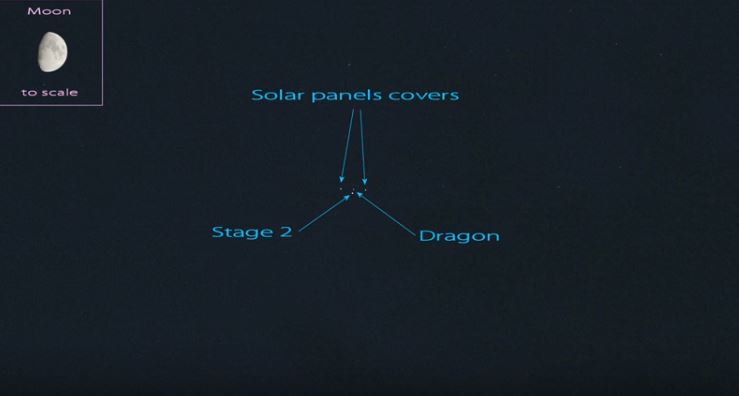
Always on the lookout for interesting events in the skies, astrophotographer Thierry Legault has captured an incredible video of SpaceX’s Dragon capsule traveling through space just 20 minutes after it launched from Kennedy Space Center on June 3, 2017.
“You can see the Dragon, the second stage of the Falcon 9 rocket, and solar panel covers,” Legault told Universe Today via email, “plus a nice surprise I discovered during processing: several fast ejections of material, certainly thrusters firing!”
Legault captured at least 6 ejections of material during the passage over his location in Tours, France. The three brightest are highlighted at the end of this video. He used a Sony Alpha 7S with a 200mm lens.
So, what you’re seeing is the Dragon traveling through the background of stars. Legault hand-tracked the Dragon, so even though it appears as stationary (with a few bumps here and there) and objects are zooming past, the capsule is in fact moving at close to 17,500 mph (28,000 km/h). This was taken a just few minutes after the capsule separated from the Falcon nine upper stage and jettisoned the covers on the solar panels, so all the individual bright ‘dots’ seen here were still near each other, moving together in Earth orbit.
SpaceX CRS-11 filmed from France 20min after launch: https://t.co/fwpp0iwcUv
Dragon, stage 2, solar panel covers plus material ejections! pic.twitter.com/mveRocGGII— Thierry Legault (@ThierryLegault) June 7, 2017
This Dragon is now docked at the International Space Station, as the launch was the CRS-11 (11 of 12 planned Commercial Resupply Services for SpaceX.) This was the first time that a Dragon spacecraft was reused, and it brought supplies and science experiments to the ISS. As SpaceX has now done several times, the first stage booster landed back at KSC. This was also the 100th launch from historic pad 39A. Read more about the launch and mission here.
This isn’t the first time Legault has captured the Dragon in flight; he also shot footage of Dragon on its way to the ISS in April of 2014. Recently, he also was able to take multiple images of the ISS passing in front of the Moon:
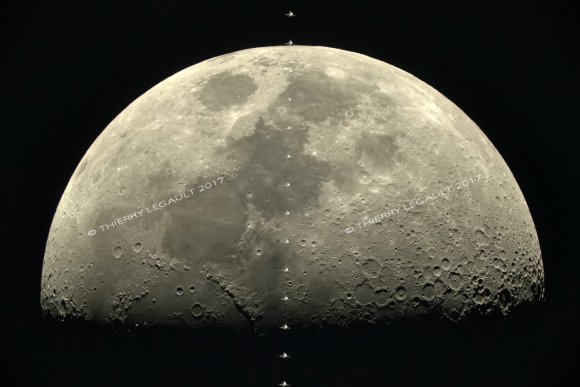
Expedition 50 with French astronaut Thomas Pesquet on February 4, 2017. Filmed with Celestron C14 EdgeHD and Sony Alpha 7S from Rouen, France (Pesquet’s birth city). Credit and copyright: Thierry Legault. Used by permission.
Thanks to Thierry for sharing his footage and images with Universe Today. Keep track of his amazing work at his website.
SpaceX & NASA Studying 2020 Landing Sites For Dragon
As part of their effort to kick-start the eventual colonization of Mars, SpaceX is sending an unmanned Dragon spacecraft to Mars. Initially, that mission was set for 2018, but is now re-scheduled for 2020. Now, SpaceX says they’re working with NASA to select a suitable landing site for their first Dragon mission to Mars.
At a presentation in Texas on March 18th, Paul Wooster of SpaceX said that they have been working with scientists at NASA’s Jet Propulsion Laboratory (JPL) to identify candidate landing sites on the surface of Mars. In order to aid colonization, the sites need to be:
- near the equator, for solar power
- near large quantities of ice, for water
- at low elevation, for better thermal conditions
But finding a site that meets those conditions is difficult.
According to SpaceNews, the study done with NASA initially recognized 4 regions in Mars’ northern hemisphere, all within 40 degrees of the equator. They are Deuteronilus Mensae, Phlegra Montes, Utopia Planitia, and Arcadia Planitia.
Deuteronilus Mensae
Deuteronilus Mensae (DM) is located between older, cratered highlands and low plains. DM shows evidence of glacial activity in its surface features. In fact, there are still glaciers there, which makes it a desirable source of ice.
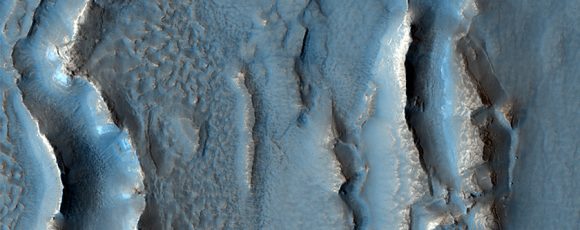
Phlegra Montes
Phlegra Montes (PM) is a system of mountains on the Martian surface, over 1300 km across. It’s a complex system of basins, hills, and ridges. They are likely tectonic in origin, rather than volcanic, and the region probably contains large quantities of water ice, perhaps 20 meters below the surface.
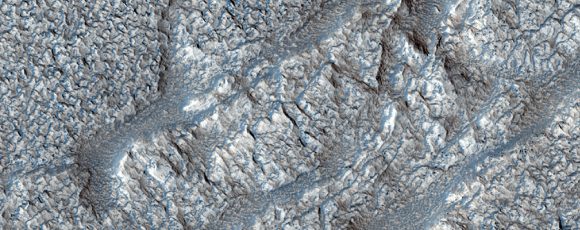
Utopia Planitia
Utopia Planitia (UP) is the region where the Viking 2 lander set down in 1976. At 3300 km in diameter, UP is the largest impact basin in the Solar System. In 2016, NASA found a huge deposit of underground ice there. The water is estimated to be the same volume as Lake Superior.
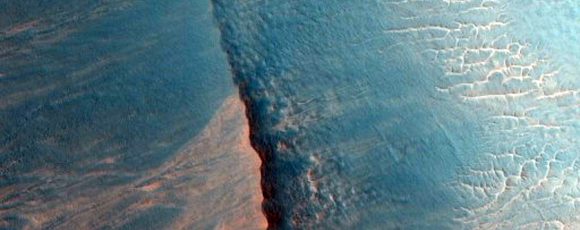
Arcadia Planitia
Arcadia Planitia (AP) is a smooth plain containing fresh lava flows. It also has a large region that was shaped by periglacial processes. This supports the idea that ice is present just beneath the surface, making it a candidate for colonization efforts.
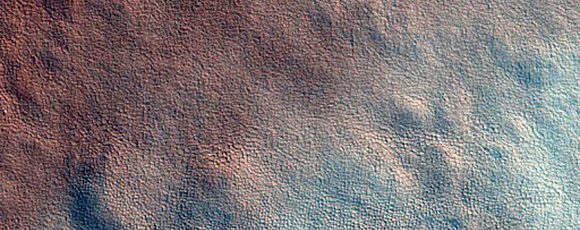
The image below shows the Arcadia Planitia region in relation to some of its surroundings. Colonists at AP might have a great view of Olympus Mons, the largest volcano in the Solar System.
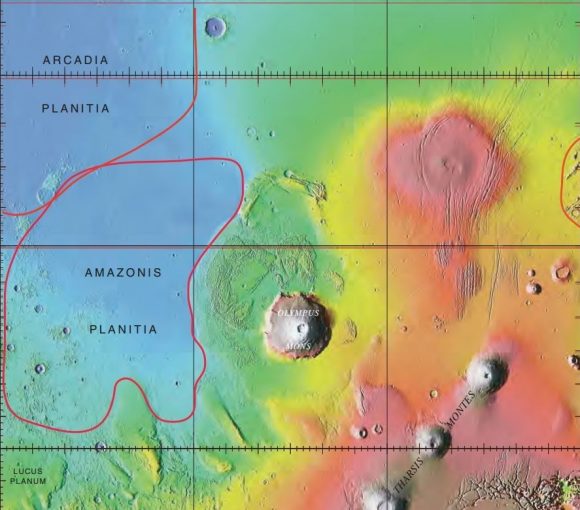
The four areas looked suitable in images from a medium resolution camera (CTX) on the Mars Reconnaissance Orbiter (MRO). But when the High Resolution Imaging Science Experiment (HiRISE) camera on the same orbiter was used to look more closely, the first three locations appeared to be much rockier. According to SpaceNews, Wooster said ““The team at JPL has been finding that, while the areas look very flat and smooth at CTX resolution, with HiRISE images, they’re quite rocky. That’s been unfortunate in terms of the opportunities for those sites.”
The fourth area, Arcadia Planitia, is a more promising site. HiRISE images showed that it is much less rocky and could be a suitable site for the first Dragon mission to Mars.
The Dragon mission to Mars is just the first step for SpaceX. They see themselves as an interplanetary transportation company eventually. SpaceX intends to send a craft to Mars every two years, when the launch window is optimal. SpaceX says they’ll have the ability to deliver one ton of payload to the Martian surface with each Dragon mission.
Their Interplanetary Transport System (ITS) might have the capability to make it to Mars in as little as 80 days, while carrying a payload of up to 450 tons. While still in the very initial stages of design, it may eventually revolutionize our ability to colonize Mars in any meaningful or enduring way. SpaceX envisions a fleet of craft in the ITS which will constantly make the return to trip to Mars.
If that ever happens, we may look at the first Dragon mission to Arcadia Planitia, or another eventual landing site, as the first step.
Drone Captures Amazing Footage of Falcon 9 Landing
Let’s just take a moment to admire how amazing it is when science fiction becomes routinely real:
https://www.instagram.com/p/BQtNTk4Brqp/
SpaceX CEO Elon Musk shared this amazing drone footage of the Falcon 9 rocket’s first stage returning for a perfect landing after the launch of the Dragon capsule to the International Space Station. It drops flawlessly through the clouds, easy as pie, touching down at SpaceX’s Landing Zone 1 at Cape Canaveral.
As cool as the first stage landing was, the launch had a notable starting place. As our Ken Kremer reported yesterday, “the era of undesired idleness for America’s most famous launch pad was broken at last by the rumbling thunder of a SpaceX Falcon 9.” The SpaceX launch took place on the historic Launchpad 39-A, the same spot where Apollo astronauts began their journey to the Moon and space shuttles set off on their missions.
Here’s another view of drone footage of the landing:
SpaceX’s CRS-10 resupply mission to the International Space Station was the second successful launch for the commercial space company since the launch pad explosion in September 2016. Dragon will rendezvous and be docked to the ISS, on Wednesday, March 22, bringing about 5,500 pounds of supplies and experiments.
Flawless Capture and Berthing of SpaceX Dragon Supply Ship at ISS
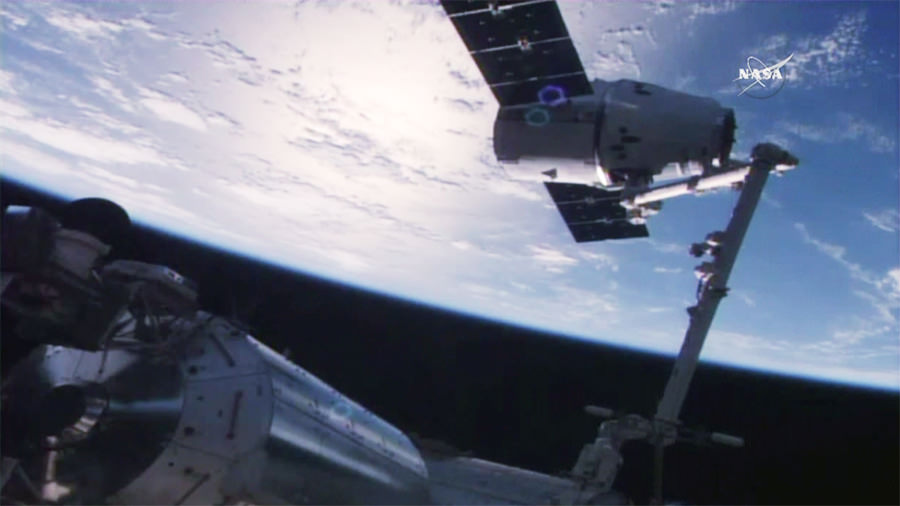
KENNEDY SPACE CENTER, FL – Following a flawless post midnight blastoff two mornings ago, a pair of NASA astronauts executed a flawless capture of the newest SpaceX Dragon supply ship at the International Space Station early this morning, July 20, carrying 2.5 tons of priceless research equipment and gear for the resident astronauts and cosmonauts.
As the orbiting outpost was traveling 252 statute miles over the Great Lakes, NASA’s veteran Expedition 48 Commander Jeff Williams and newly arrived NASA Flight Engineer Kate Rubins used the station’s 57.7-foot (17.6-meter) Canadian-built robotic arm to reach out and capture the Dragon CRS-9 spacecraft at 6:56 a.m. EDT.
“Good capture confirmed after a two day rendezvous,” said Houston Mission Control at NASA’s Johnson Space Center, as Dragon was approximately 30 feet (10 meters) away from the station.
“We’ve captured us a Dragon,” radioed Williams.
“Congratulations to the entire team that put this thing together, launched it, and successfully rendezvoused it to the International Space Station. We look forward to the work that it brings.”
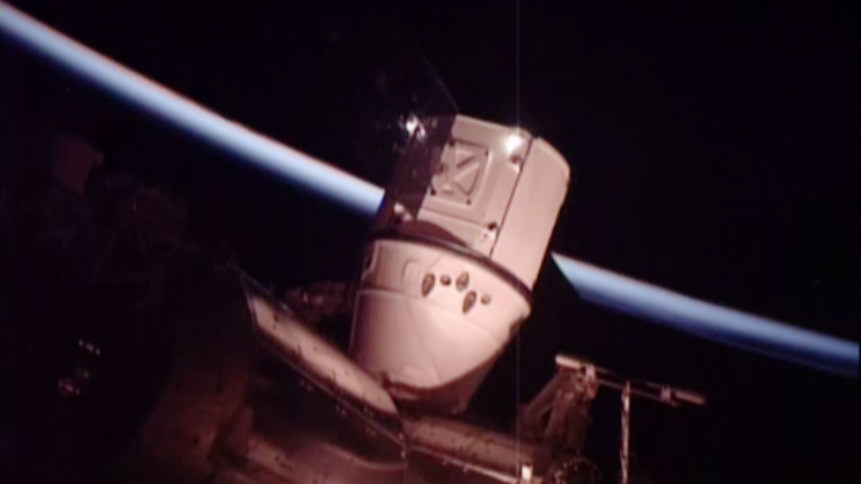
The events unfolded live on a NASA TV webcast for all to follow along.
Furthermore, today’s dramatic Dragon arrival coincides with a renowned day in the annuls of space history. Today coincides with the 40th anniversary of humanity’s first successful touchdown on the surface of Mars by NASA’s Viking 1 lander on July 20, 1976. It paved the way for many future missions.
And Neil Armstrong and Buzz Aldrin were the first humans to land on another celestial body – the Moon – on July 20, 1969 during NASA’s Apollo 11 lunar landing mission.
Williams was working from a robotics work station in the station’s domed cupola. Rubins was Williams backup. She just arrived at the station on July 9 for a minimum 4 month stay, after launching to orbit on a Russian Soyuz on July 6 with two additional crew mates.
Ground controllers then used the robotic arm to maneuver the Dragon cargo spacecraft closer to its berthing port on the Earth facing side of the Harmony module, located at the front of the station.
Some three hours after the successful grappling, Dragon was joined to the station and bolted into place for initial berthing on the Harmony module at 10:03 a.m. EDT as the station flew about 252 statute miles over the California and Oregon border.
Controllers then activated four gangs of four bolts in the common berthing mechanism (CBM) to complete the second stage capture of the latching and berthing of Dragon to the station with a total of 16 bolts to ensure a snug connection, safety and no pressure leaks.
Crew members Williams and Rubins along with Japanese astronaut Takuya Onishi are now working to install power and data cables from the station to Dragon. They plan to open the hatch tomorrow after pressurizing the vestibule in the forward bulkhead between the station and Dragon.
Dragon reached the station after a carefully choreographed orbital chase and series of multiple thruster firings to propel the cargo ship from its preliminary post launch orbit up to the massive million pound science outpost with six resident crew members from the US, Russia and Japan.
Among the 5000 pounds of equipment on board is the first of two identical docking adapters essential for enabling station dockings next year by NASA’s new commercial astronaut taxis. This mission is all about supporting NASA’s ‘Journey to Mars’ by humans in the 2030s.
Liftoff of the SpaceX Falcon 9 rocket in its upgraded, full thrust version and the Dragon CRS-9 resupply ship took place barely 48 hours ago at 12:45 a.m. EDT Monday, July 18, from Space Launch Complex 40 at Cape Canaveral Air Force Station in Florida.

Dragon reached its preliminary orbit about 10 minutes after launch and then deployed a pair of solar arrays.
SpaceX also successfully executed a spellbinding ground landing of the Falcon 9 first stage back at Cape Canaveral Air Force Station’s Landing Zone 1, located a few miles south of launch pad 40.
The dramatic ground landing of the 156 foot tall Falcon 9 first stage at LZ -1 took place about 9 minutes after liftoff. It marks only the second time a spent orbit class booster has touched down intact and upright on land.
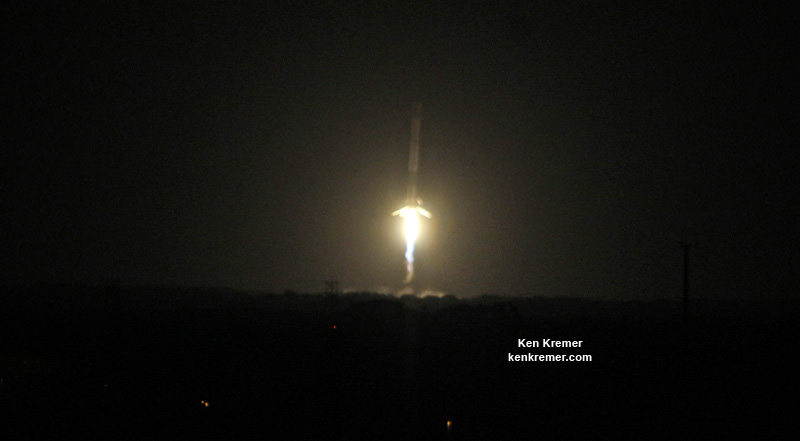
Among the wealth of over 3900 pounds (1790 kg) of research investigations loaded on board Dragon is an off the shelf instrument designed to perform the first-ever DNA sequencing in space and the first international docking adapter (IDA) that is absolutely essential for docking of the SpaceX and Boeing built human spaceflight taxis that will ferry our astronauts to the International Space Station (ISS) in some 18 months.
Other science experiments on board include OsteoOmics to test if magnetic levitation can accurately simulate microgravity to study different types of bone cells and contribute to treatments for diseases like osteoporosis, a Phase Change Heat Exchanger to test temperature control technology in space, the Heart Cells experiments that will culture heart cells on the station to study how microgravity changes the human heart, new and more efficient three-dimensional solar cells, and new marine vessel tracking hardware known as the Automatic Identification System (AIS) that will aid in locating and identifying commercial ships across the globe.
The ring shaped IDA-2 unit is stowed in the Dragon’s unpressurized truck section. It weighs 1029 lbs (467 kg), measures about 42 inches tall and sports an inside diameter of 63 inches in diameter – so astronauts and cargo can easily float through. The outer diameter measures about 94 inches.
“Outfitted with a host of sensors and systems, the adapter is built so spacecraft systems can automatically perform all the steps of rendezvous and dock with the station without input from the astronauts. Manual backup systems will be in place on the spacecraft to allow the crew to take over steering duties, if needed,” says NASA.
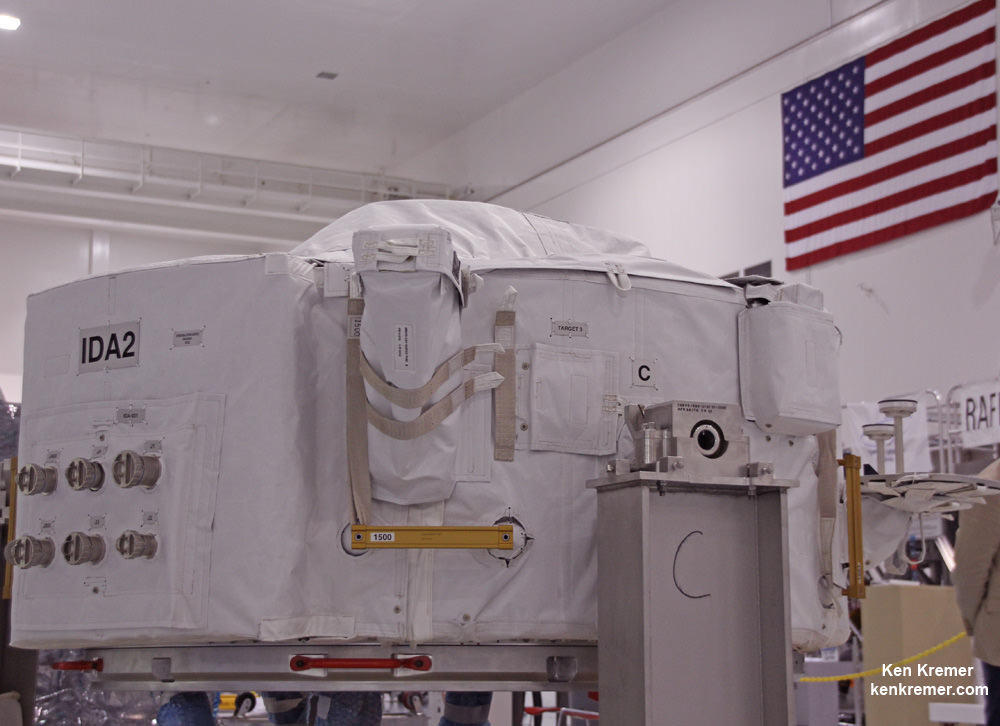
“It’s a passive system which means it doesn’t take any action by the crew to allow docking to happen and I think that’s really the key,” said David Clemen Boeing’s director of Development/Modifications for the space station.
“Spacecraft flying to the station will use the sensors on the IDA to track to and help the spacecraft’s navigation system steer the spacecraft to a safe docking without astronaut involvement.”
CRS-9 counts as the company’s ninth scheduled flight to deliver supplies, science experiments and technology demonstrations to the International Space Station (ISS).
The CRS-9 mission is for the crews of Expeditions 48 and 49 to support dozens of the approximately 250 science and research investigations in progress under NASA’s Commercial Resupply Services (CRS) contract.
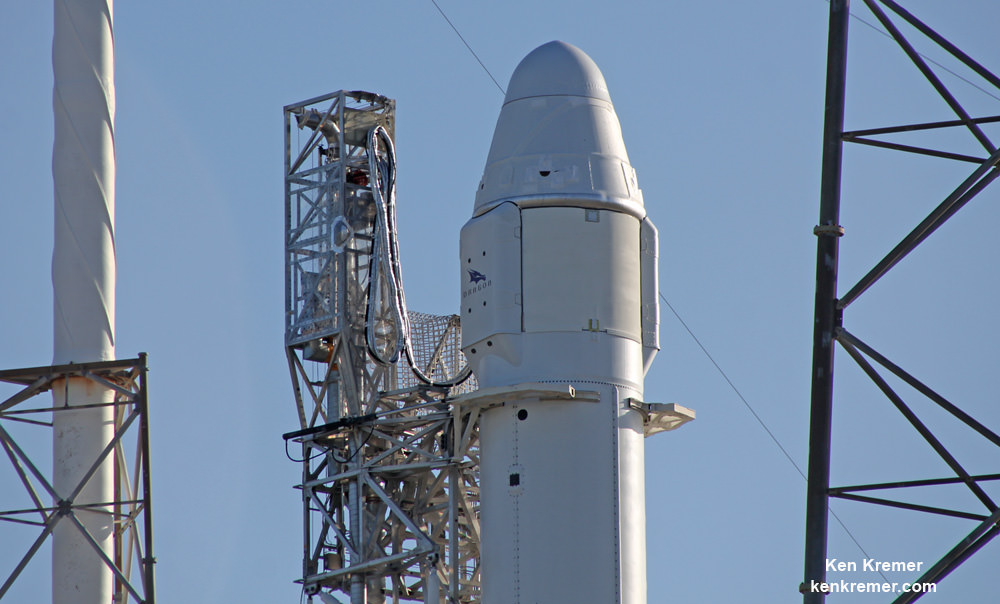
Dragon will remain at the station until its scheduled departure on Aug. 29 when it will return critical science research back to Earth via a parachute assisted splashdown in the Pacific Ocean off the California coast.
Watch for Ken’s continuing CRS-9 mission coverage where he reported onsite direct from the Kennedy Space Center and Cape Canaveral Air Force Station, Florida.
Stay tuned here for Ken’s continuing Earth and Planetary science and human spaceflight news.
Sensational Photos Show ‘Super Smooth’ Droneship Touchdown of SpaceX Falcon 9 Booster – SpaceX VP
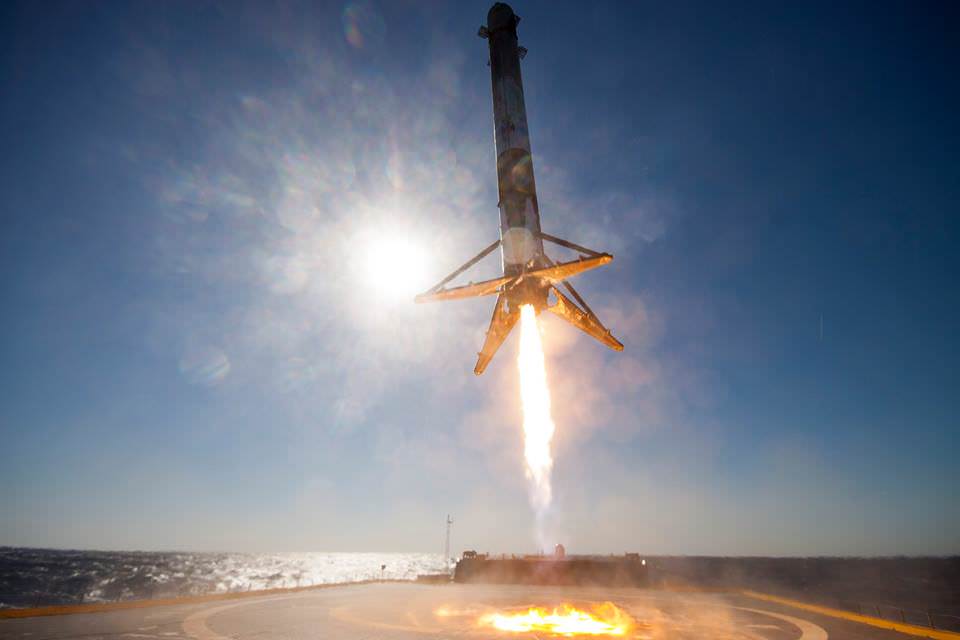

SpaceX has released a slew of up close photos showing the sensational “super smooth” touchdown last week of a Falcon 9 booster on a tiny droneship at sea located several hundred miles (km) off the East coast of Florida.
“This time it really went super smooth,” Hans Koenigsmann, SpaceX VP of Flight Reliability, told Universe Today at the NorthEast Astronomy and Space Forum (NEAF) held in Suffern, NY. “The rest is history almost.”
The dramatic propulsive descent and soft landing of the SpaceX Falcon 9 first stage took place last Friday, April 8 about 9 minutes after blasting off from Cape Canaveral Air Force Station at 4:43 p.m. EDT on the Dragon CRS-8 resupply mission for NASA to the International Space Station (ISS).
The breathtaking new photos show the boosters central Merlin 1D engine refiring to propulsively slow the first stage descent with all four landing legs unfurled and locked in place at the bottom and all four grid fins deployed at the top.
Why did it all go so well, comparing this landing to the prior attempts? Basically the return trajectory was less challenging due to the nature of the NASA payload and launch trajectory.
“We were more confident about this droneship landing,” Koenigsmann said at NEAF.
“I knew the trajectory we had [for CRS-8] was more benign, although not super benign. But certainly benigner than for what we had before on the SES-9 mission, the previous one. The [droneship] landing trajectory we had for the previous one on SES-9 was really challenging.”
“This one was relatively benign. It was really maybe as benign as for the Orbcomm launch [in December 2015] where we had the land landing.”
Read my Orbcomm story here about history’s first ever successful land landing of a spent SpaceX Falcon 9 booster.

The diminutive ocean landing platform measures only about 170 ft × 300 ft (52 m × 91 m). SpaceX formally dubs it an ‘Autonomous Spaceport Drone Ship’ or ASDS.
The ocean going ship is named “Of Course I Still Love You” after a starship from a novel written by Iain M. Banks.
It was stationed some 200 miles off shore of Cape Canaveral, Florida surrounded by the vastness of the Atlantic Ocean.

“The CRS-8 launch was one of the easiest ones we ever had.”
The revolutionary rocket recovery event counts as the first successful droneship landing of a rocket in history and is paving the way towards eventual rocket recycling aimed at dramatically slashing the cost of access to space.
The final moments of the 15 story tall boosters approach and hover landing was captured up close in stunning high resolution imagery recorded by multiple remote cameras set up right on the ocean going platform by SpaceX photographer Ben Cooper.
Landing the booster on land rather than at sea was actually an option this time around. But SpaceX managers wanted to try and nail a platform at sea landing to learn more and validate their calculations and projections.
“As Elon Musk said at the post-landing press conference of Friday, we could have actually come back to land- to land this one on land,” Koenigsmann elaborated.
“But we decided to land on the drone ship first to make sure that on the droneship we had worked everything out!”
“And that’s exactly what happened. So I felt this was only going out a little bit on the limb,” but not too much.”

Before the CRS-8 launch, Koenigsmann had rated the chances of a successful landing recovery rather high.
Three previous attempts by SpaceX to land on a droneship at sea were partially successful, as the stage made a pinpoint flyback to the tiny droneship, but it either hit too hard or tipped over in the final moments when a landing leg failed to fully deploy or lock in place.
“Everything went perfect with the launch,” Koengismann said. “We just still have to do the post launch data review.”
“I am really glad this went well.”
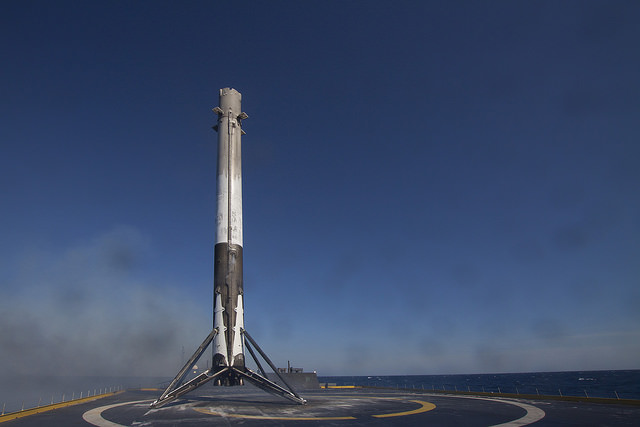
This recovered Falcon 9 booster finally arrived back into Port Canaveral, Florida four days later in the early morning hours of Tuesday, April 12 at about 1:30 a.m. EDT.
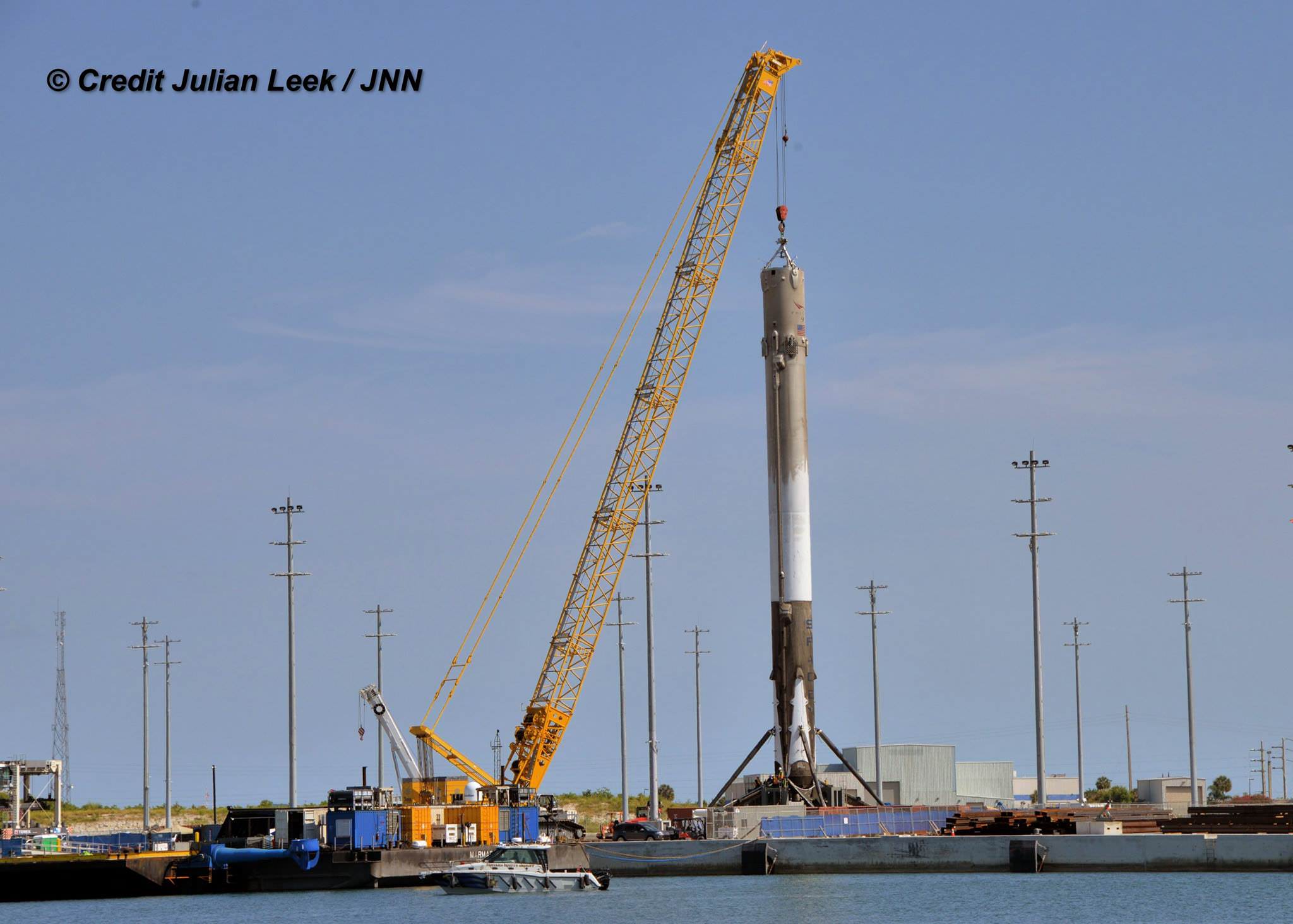
The primary goal of the Falcon 9 launch on April 8 was carrying the SpaceX Dragon CRS-8 cargo freighter to low Earth orbit on a commercial resupply delivery mission for NASA to the International Space Station (ISS).
Dragon arrived at the station on Sunday, April 10, loaded with 3 tons of supplies, science experiments and the BEAM experimental expandable module.
Landing on the barge was a secondary goal of SpaceX and not part of the primary mission for NASA.
Watch this launch video from my video camera placed at the pad:
Video Caption: Spectacular blastoff of SpaceX Falcon 9 rocket carrying Dragon CRS-8 cargo freighter bound for the International Space Station (ISS) from Space Launch Complex 40 on Cape Canaveral Air Force Station, FL at 4:43 p.m. EST on April 8, 2016. Up close movie captured by Mobius remote video camera placed at launch pad. Credit: Ken Kremer/kenkremer.com
The recovered booster will be cleaned and defueled, says SpaceX spokesman John Taylor.
SpaceX engineers will conduct a series of 12 test firings to ensure all is well operationally and that the booster can be re-launched.
SpaceX hopes to refly the recovered booster in a few months, perhaps as early as this summer.

Stay tuned here for Ken’s continuing Earth and planetary science and human spaceflight news.
………….
Learn more about SpaceX, NASA Mars rovers, Orion, SLS, ISS, Orbital ATK, ULA, Boeing, Space Taxis, NASA missions and more at Ken’s upcoming outreach events:
Apr 17: “NASA and the Road to Mars Human Spaceflight programs”- 1:30 PM at Washington Crossing State Park, Nature Center, Titusville, NJ – http://www.state.nj.us/dep/parksandforests/parks/washcros.html
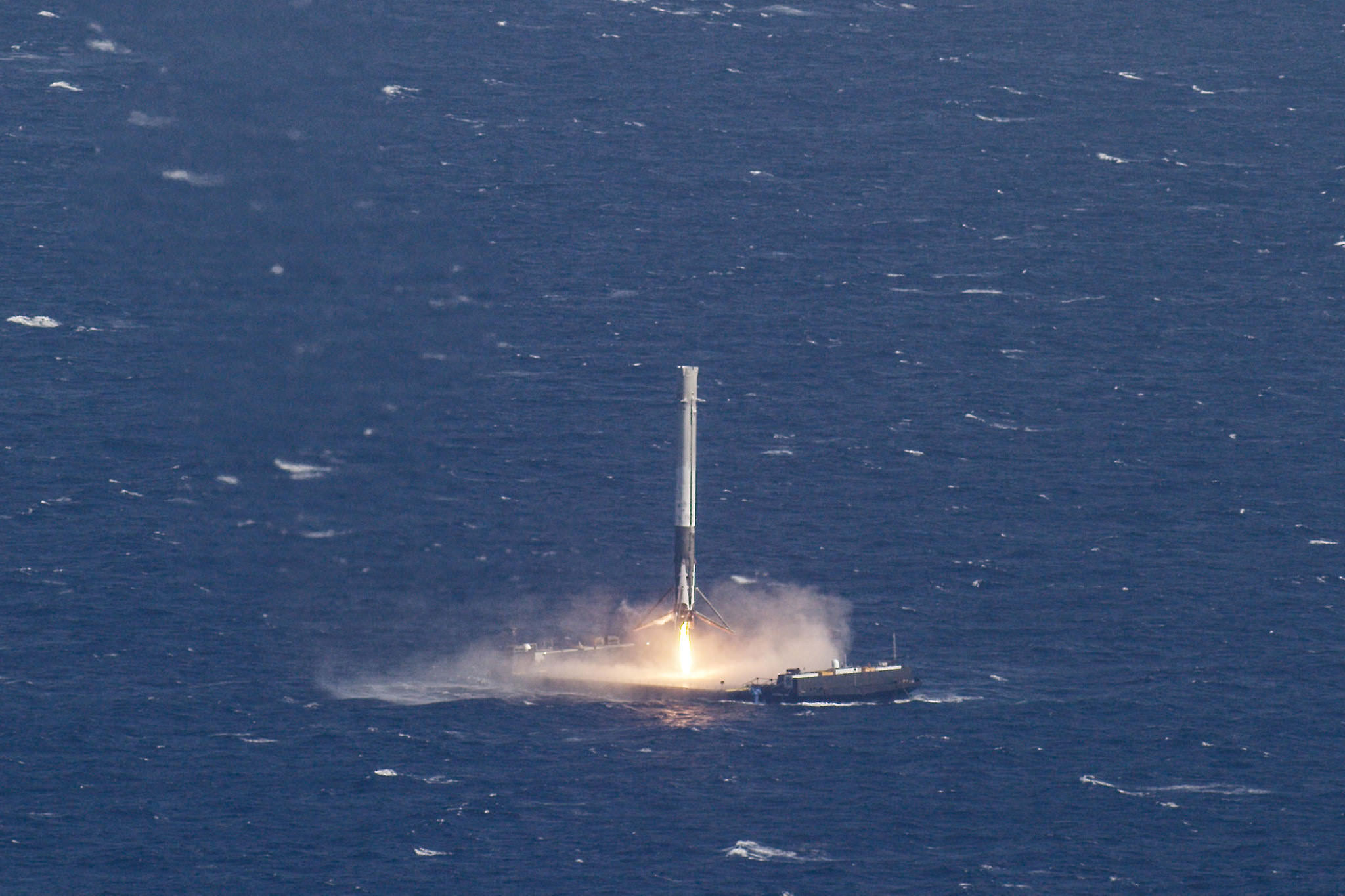
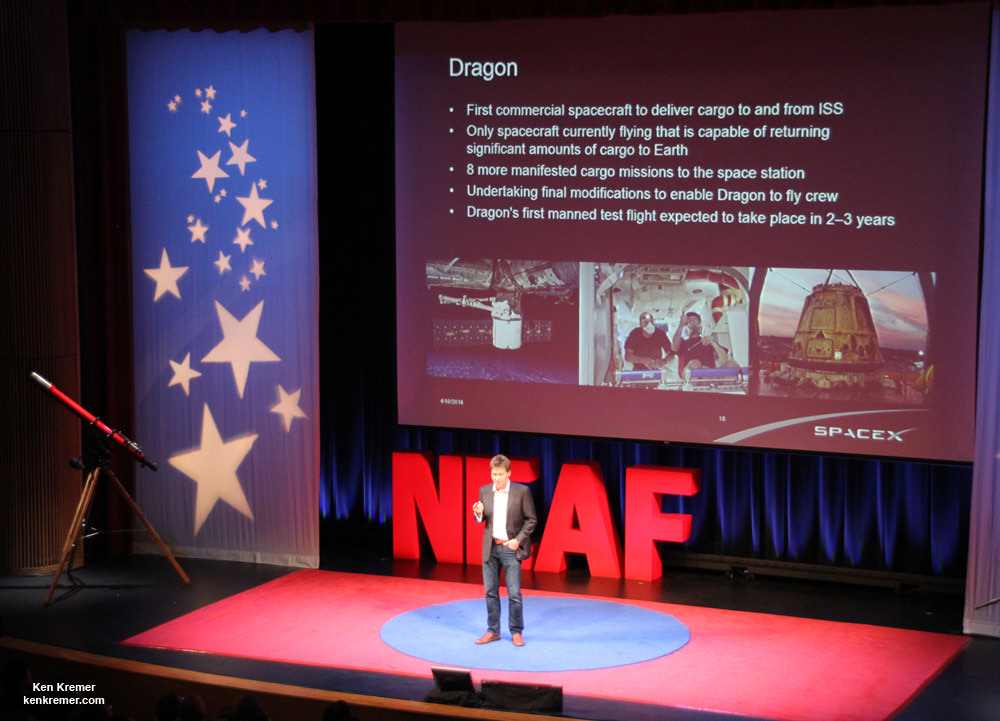
SpaceX Falcon 9 Recovered 1st Stage Arrives Back in Port After Historic Upright Landing at Sea
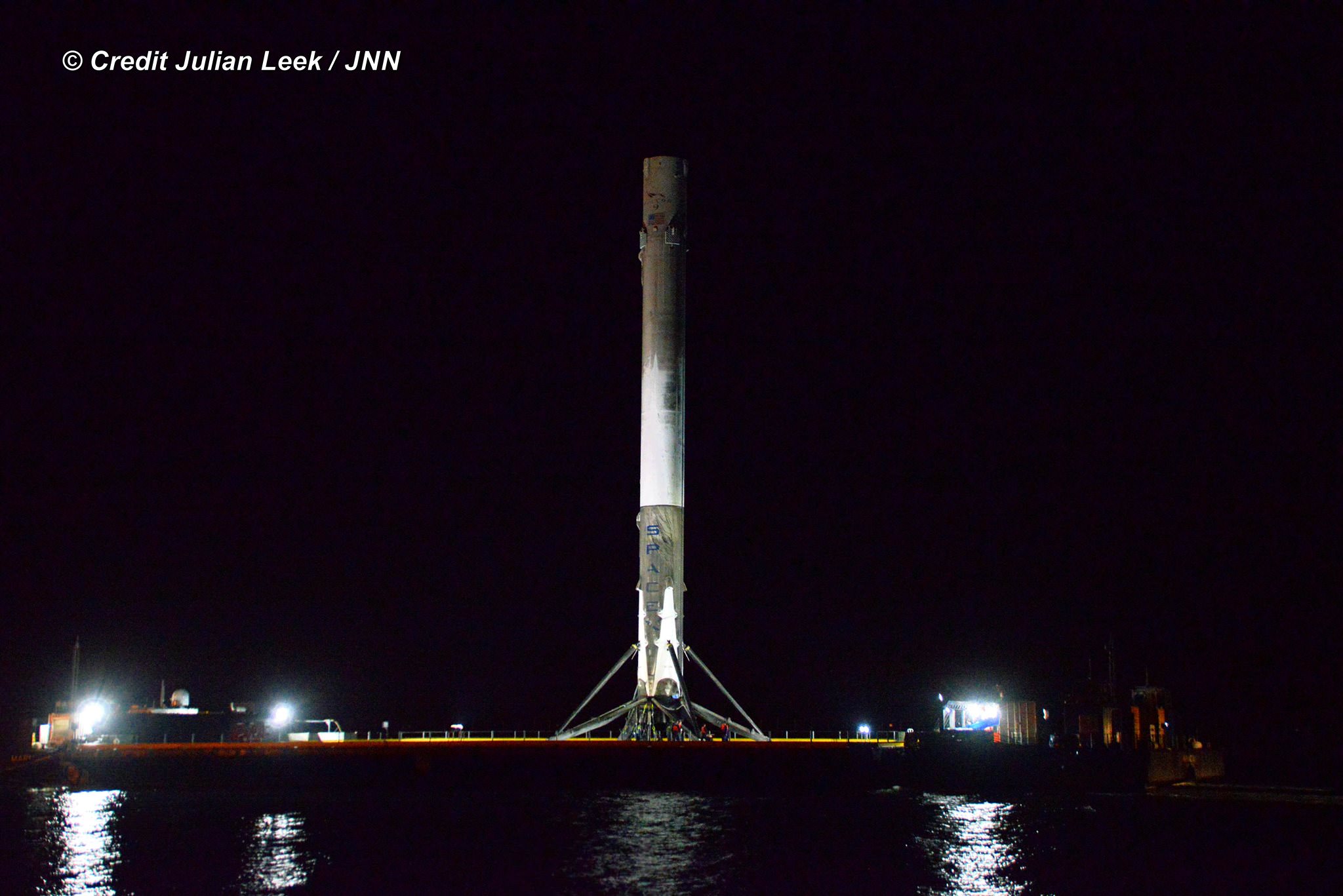

The SpaceX Falcon 9 that triumphantly accomplished history’s first upright landing of the spent first stage of a rocket on a barge at sea – after launching a critical cargo payload to orbit for NASA – sailed back into port at Cape Canaveral overnight in the wee hours of this morning, April 12, standing tall.
The recovered 15 story tall Falcon 9 booster arrived back into Port Canaveral, Florida at about 130 a.m. early today, towed atop the ocean going platform that SpaceX dubs an ‘Autonomous Spaceport Drone Ship’ or ASDS.
The ship is named “Of Course I Still Love You” after a starship from a novel written by Iain M. Banks. The landing platform measures only about 170 ft × 300 ft (52 m × 91 m).
A small crowd of excited onlookers and space photographers savored and cheered the incredible moment that is surely changing the face and future of space exploration and travel.
The two stage SpaceX Falcon 9 rocket boasting over 1.5 million pounds of thrust originally launched on Friday, April 8 at 4:43 p.m. EDT from Space Launch Complex 40 at Cape Canaveral Air Force Station in Florida.
The primary goal of the Falcon 9 launch was carrying the SpaceX Dragon CRS-8 cargo freighter to low Earth orbit on a commercial resupply delivery mission for NASA to the International Space Station (ISS).
Before the launch, SpaceX managers rated the chances of a successful landing recovery rather high.
Three previous attempts by SpaceX to land on a barge at sea were partially successful, as the stage made a pinpoint flyback to the tiny ship but either hit too hard or tipped over in the final moments when a landing leg failed to fully deploy or lock in place.
“We were very optimistic of the chances of a successful landing on this mission,” Hans Koenigsmann told Universe Today in an exclusive post landing interview at the NorthEast Astronomy and Space Forum (NEAF) held in Suffern, NY.
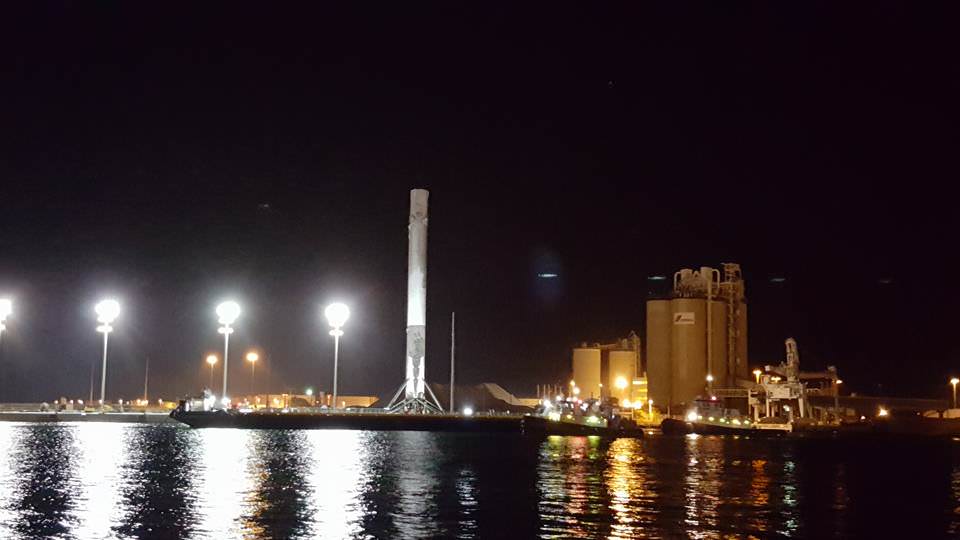
Coincidentally, today marks two major anniversaries in the history of space flight; the 55th anniversary of the launch of Russia’s Yuri Gagarin, the first man in space on Vostok-1 on April 12, 1961; and the 35th anniversary of the launch of shuttle Columbia on America’s first space shuttle mission (STS-1) on April 12, 1981 with John Young and Bob Crippen.
The vision of SpaceX’s billionaire founder and CEO Elon Musk is to dramatically slash the cost of access to space by recovering the firms rockets and recycling them for reuse – so that launching rockets will one day be nearly as routine and cost effective as flying on an airplane.
The stage will now be painstakingly inspected, tested and refurbished.
The essential next step after recovery is recycling. Musk said he hopes to re-launch the booster this year.
At liftoff, Dragon was loaded with over 3.5 tons of research experiments and essential supplies for the six man crew living aboard the orbiting science complex.
Watch this launch video from my video camera placed at the pad:
Video Caption: Spectacular blastoff of SpaceX Falcon 9 rocket carrying Dragon CRS-8 cargo freighter bound for the International Space Station (ISS) from Space Launch Complex 40 on Cape Canaveral Air Force Station, FL at 4:43 p.m. EST on April 8, 2016. Up close movie captured by Mobius remote video camera placed at launch pad. Credit: Ken Kremer/kenkremer.com
The Dragon CRS-8 cargo ship successfully arrived at the station on Sunday, April 10 and was joined to the million pound station at the Earth-facing port of the Harmony module.
The secondary objective was to try and land the Falcon 9 first stage on the ASDS done ship located some 200 miles off shore in the Atlantic Ocean.
The action-packed and propulsive landing took place some 10 minutes after liftoff.
In the final moments of the descent to the drone ship, one of the first stage Merlin 1D engines was reignited to slow the boosters descent speed as the quartet of side-mounted landing legs at the boosters base were unfurled, deployed and locked into place.
The entire launch and landing sequence was webcast live on NASA TV and by SpaceX.
The recovered booster atop the “Of Course I Still Love You” barge was towed back to port by the Elsbeth III tug.
“Home sweet home”, said my friend and veteran space photographer Julian Leek, who witnessed the boosters arrival back in port overnight.
“It was really a sight to see. Pilots and tugs did a well coordinated job to bring her in.”
After daylight dawned, a crane lifted the recovered booster into a storage cradle where it will remain upright for a few days. Then it will be lowered and placed horizontally for transport a few miles north to a SpaceX processing hanger back at pad 39A at the Kennedy Space Center.

The booster will be cleaned and defueled, SpaceX spokesman John Taylor told the media.
SpaceX engineers will conduct a series of 12 test firings to ensure all is well operationally and that the booster can be re-launched.
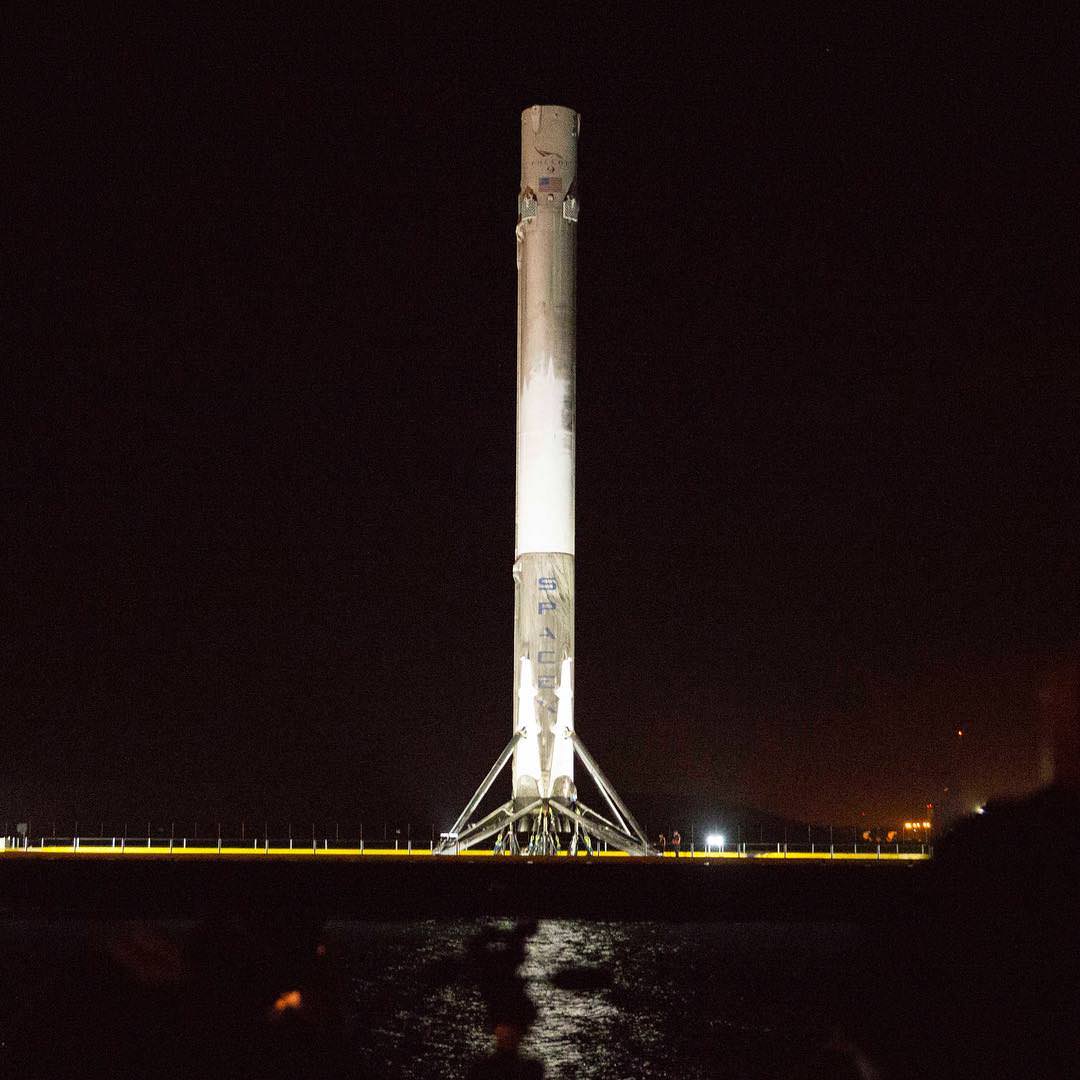
Stay tuned here for Ken’s continuing Earth and planetary science and human spaceflight news.
………….
Learn more about SpaceX, NASA Mars rovers, Orion, SLS, ISS, Orbital ATK, ULA, Boeing, Space Taxis, NASA missions and more at Ken’s upcoming outreach events:
Apr 12: Hosting Dr. Jim Green, NASA, Director Planetary Science, for a Planetary sciences talk about “Ceres, Pluto and Planet X” at Princeton University; 7:30 PM, Amateur Astronomers Assoc of Princeton, Peyton Hall, Princeton, NJ – http://www.princetonastronomy.org/
Apr 17: “NASA and the Road to Mars Human Spaceflight programs”- 1:30 PM at Washington Crossing State Park, Nature Center, Titusville, NJ – http://www.state.nj.us/dep/parksandforests/parks/washcros.html
SpaceX Dragon Carrying New Inflatable Room Captured and Mated to Space Station
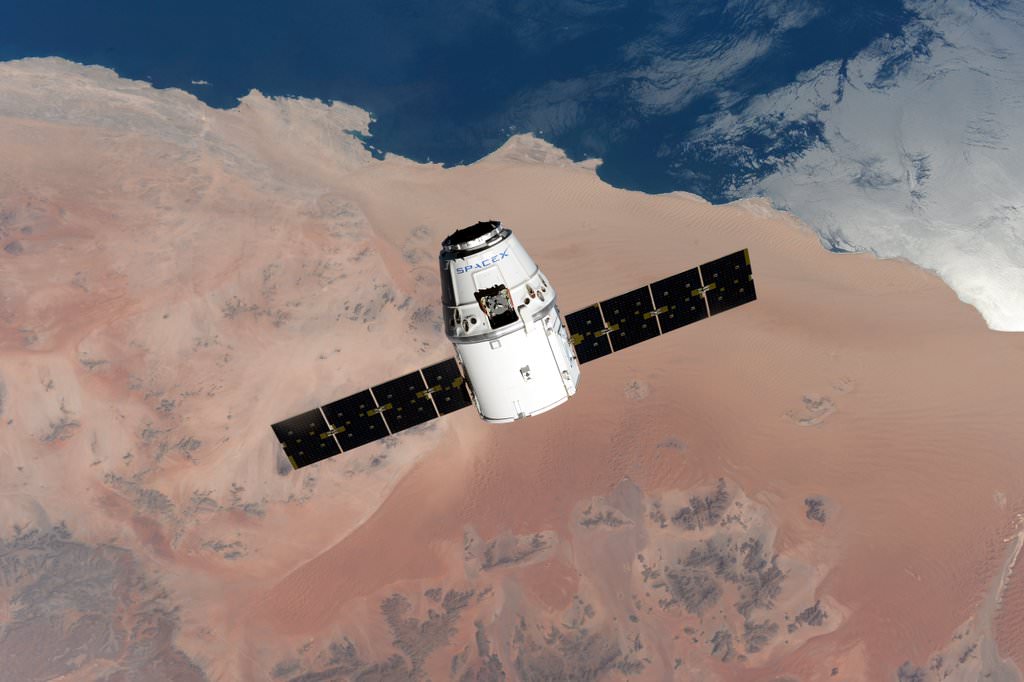

A SpaceX commercial cargo freighter jam packed with more than three and a half tons of research experiments, essential crew supplies and a new experimental inflatable habitat reached the International Space Station (ISS) and the gleeful multinational crew of six astronauts and cosmonauts on Sunday, April 10.
The U.S. SpaceX Dragon cargo craft arrived at the ISS following a carefully choreographed orbital chase inaugurated by a spectacular launch atop an upgraded SpaceX Falcon 9 rocket from Cape Canaveral Air Force Station, Florida, on Friday, April 8.
As the massive Earth orbiting outpost was soaring some 250 miles (400 kilometers) over the Pacific Ocean west of Hawaii, British astronaut Tim Peake of ESA (European Space Agency), with the able assistance of NASA’s Jeff Williams, successfully captured the SpaceX Dragon CRS-8 resupply ship with the station’s Canadian-built robotic arm.
Peake painstakingly maneuvered and deftly grappled Dragon with the snares at the terminus of the 57 foot long (19 meter long) Canadarm2 at 7:23 a.m. EDT for installation on the million pound orbital lab complex.
“Looks like we’ve caught a Dragon,” Peake radioed back to Mission Control. The orbital operational was webcast live on NASA TV.
“Awesome capture by crewmate Tim Peake,” said fellow NASA crewmate Tim Kopra who snapped a series of breathtaking images of the approach and capture.
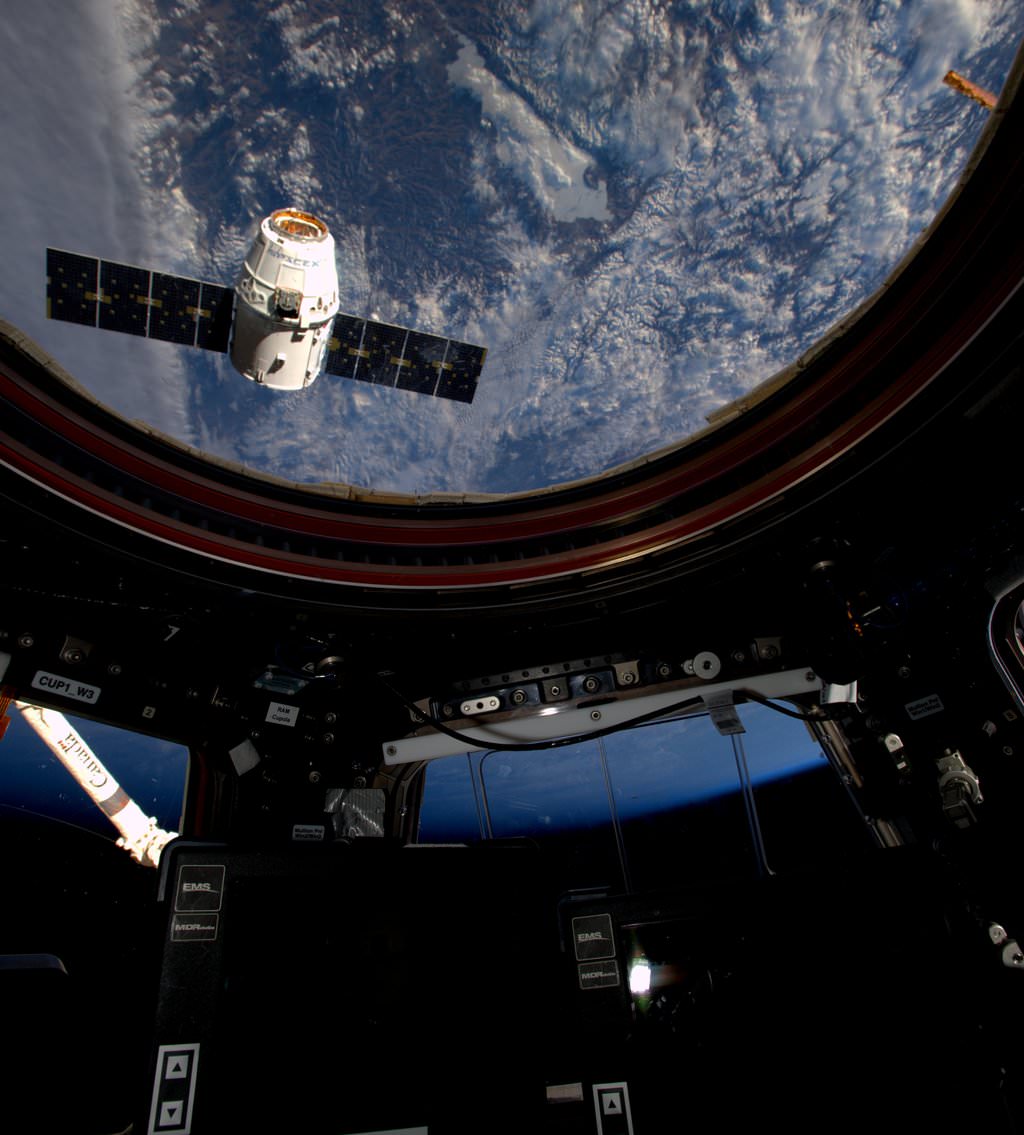
Ground controllers at Mission Control in Houston then issued commands to carefully guide the robotic arm holding the Dragon freighter to the Earth-facing port on the bottom side of the Harmony module for its month long stay at the space station.
The ship was finally bolted into place at 9:57 a.m. EDT as the station flew 250 miles (400 km) over southern Algeria.
Watch this NASA video compiling all the highlights of the arrival and mating of the SpaceX Dragon on April 10, 2016 carrying the BEAM habitat module and 3.5 tons of science and supplies. Credit: NASA
Expedition 47 crew members Jeff Williams and Tim Kopra of NASA, Tim Peake of ESA (European Space Agency) and cosmonauts Yuri Malenchenko, Alexey Ovchinin and Oleg Skripochka of Roscosmos are currently living aboard the orbiting laboratory.
In a historic first, the arrival of the SpaceX Dragon cargo spacecraft marks the first time that two American cargo ships are simultaneously docked to the ISS. The Orbital ATK Cygnus CRS-6 cargo freighter only just arrived on March 26 and is now installed at a neighboring docking port on the Unity module.
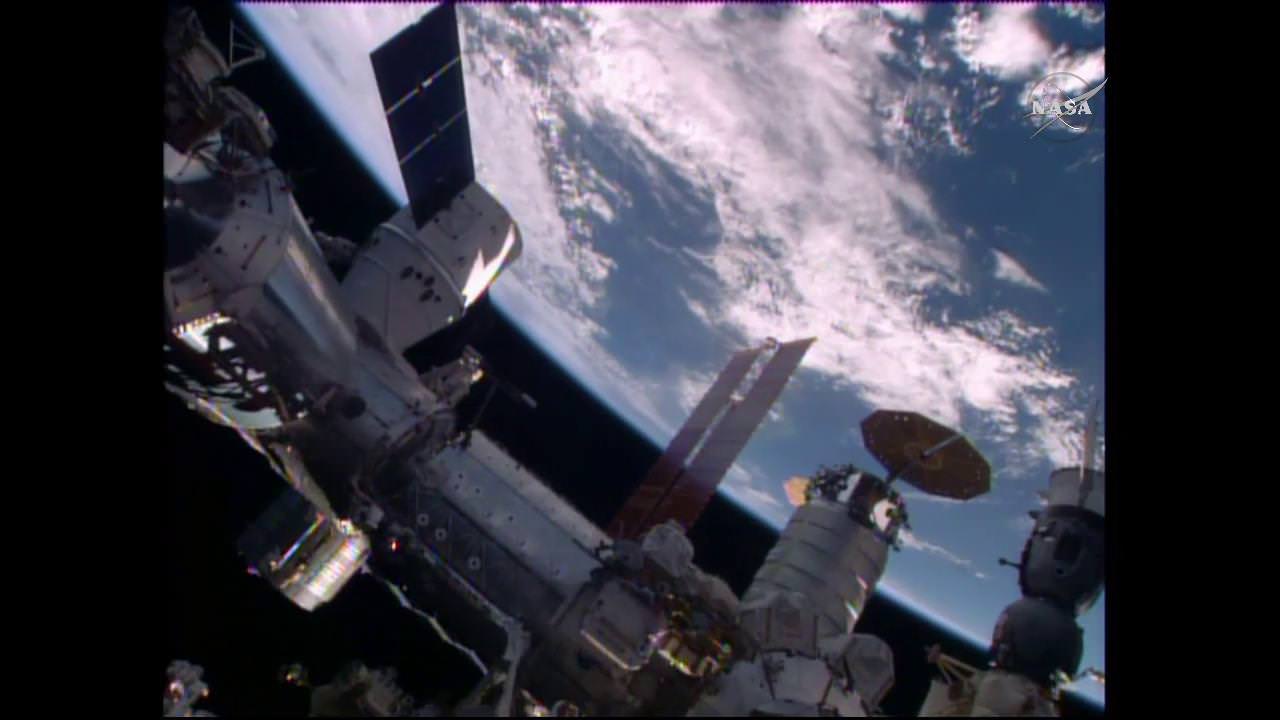
Cygnus was launched to the ISS atop a ULA Atlas V barely two weeks earlier on March 22 – as I reported on and witnessed from the Kennedy Space Center press site.
“With the arrival of Dragon, the space station ties the record for most vehicles on station at one time – six,” say NASA officials.
The Dragon spacecraft is delivering almost 7,000 pounds of cargo, including the Bigelow Expandable Activity Module (BEAM), to the orbital laboratory which was carried to orbit inside the Dragon’s unpressurized truck section.
BEAM is a prototype inflatable habitat that the crew will soon pluck from the Dragon’s truck with the robotic arm for installation on a side port of the Harmony module.
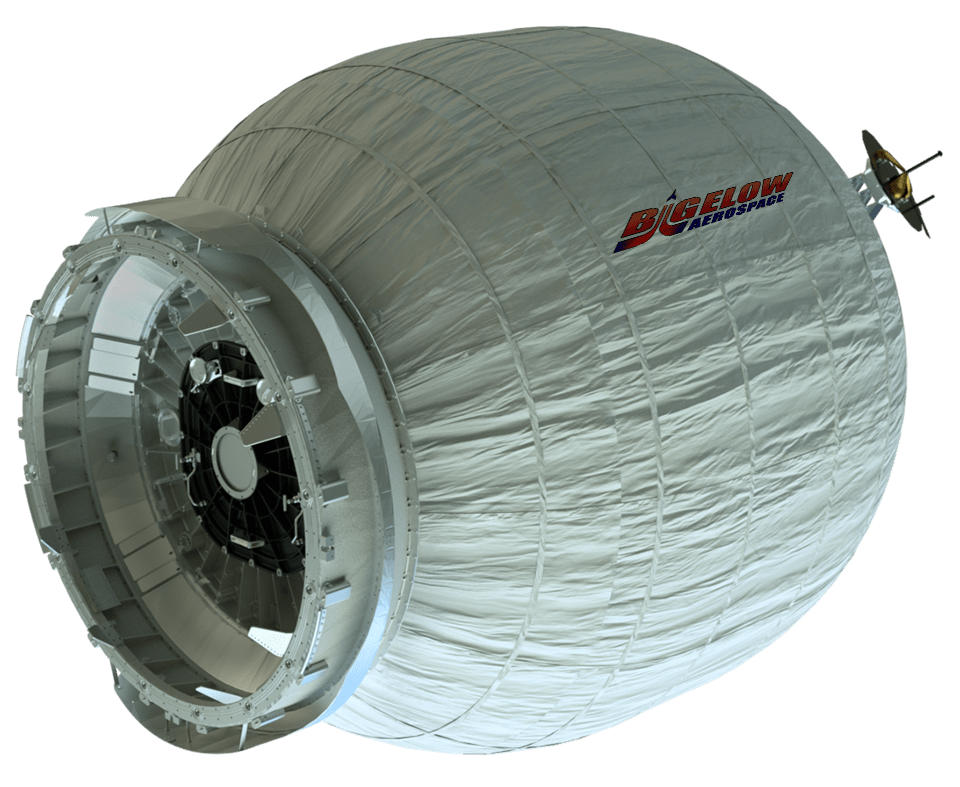
CRS-8 counts as the company’s eighth flight to deliver supplies, science experiments and technology demonstrations to the ISS for the crews of Expeditions 47 and 48 to support dozens of the approximately 250 science and research investigations in progress.
Friday’s launch marks the first for a Dragon since the catastrophic failure of the SpaceX Falcon 9 last June.
Dragon will remain at the station until it returns for Earth on May 11 for a parachute assisted splash down in the Pacific Ocean off the west coast of Baja California. It will be packed with almost 3,500 pounds off cargo and numerous science samples, including those biological samples collected by 1 year ISS crew member Scott Kelly, for return to investigators, hardware and spacewalking tools, some additional broken hardware for repair and some items of trash for disposal.
Video caption: 5 camera views of the SpaceX Falcon 9 launch of the CRS-8 mission to the ISS on 04/08/2016. Credit: Jeff Seibert/AmericaSpace
Stay tuned here for Ken’s continuing Earth and planetary science and human spaceflight news.
………….
Learn more about SpaceX, NASA Mars rovers, Orion, SLS, ISS, Orbital ATK, ULA, Boeing, Space Taxis, NASA missions and more at Ken’s upcoming outreach events:
Apr 12: Hosting Dr. Jim Green, NASA, Director Planetary Science, for a Planetary sciences talk about “Ceres, Pluto and Planet X” at Princeton University; 7:30 PM, Amateur Astronomers Assoc of Princeton, Peyton Hall, Princeton, NJ – http://www.princetonastronomy.org/
Apr 17: “NASA and the Road to Mars Human Spaceflight programs”- 1:30 PM at Washington Crossing State Park, Nature Center, Titusville, NJ – http://www.state.nj.us/dep/parksandforests/parks/washcros.html


